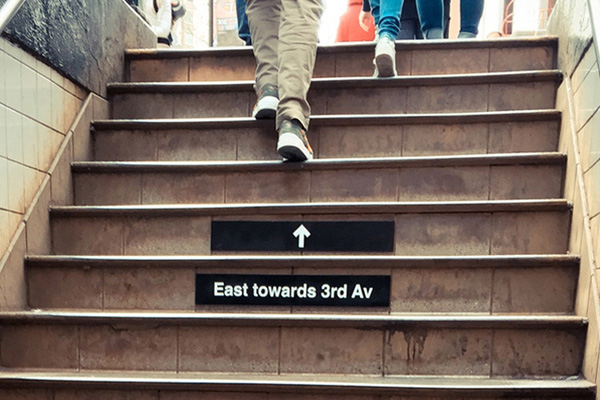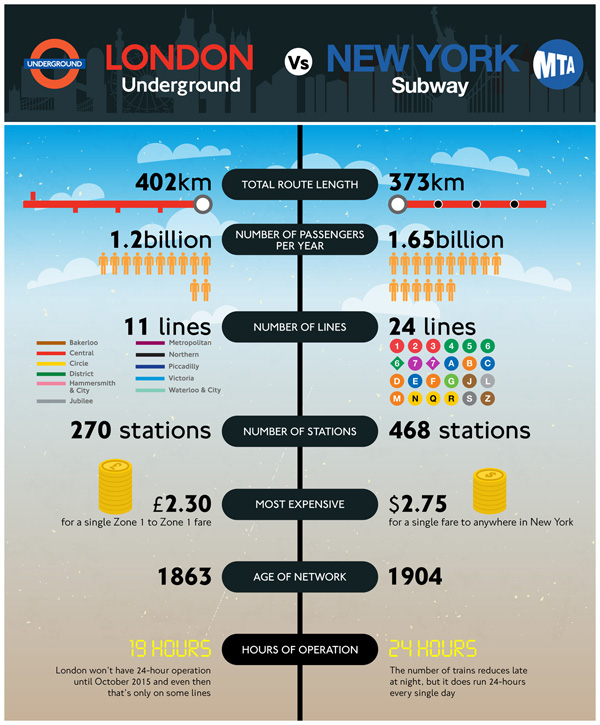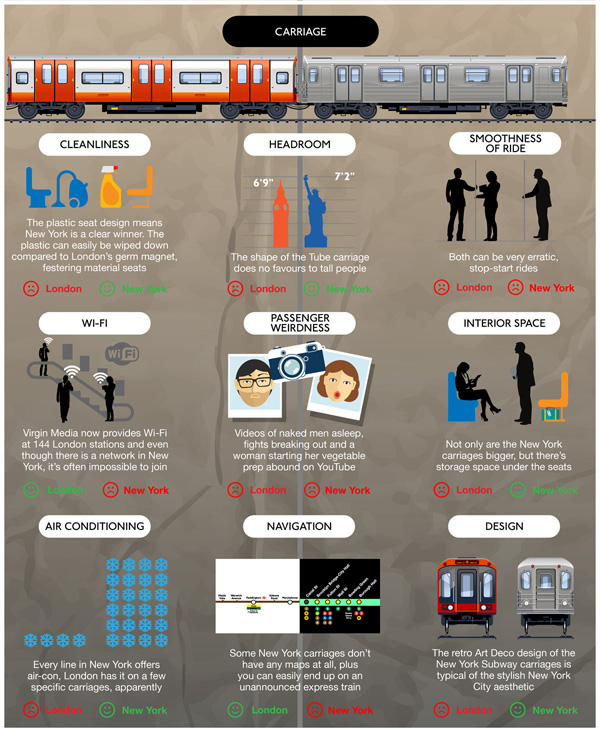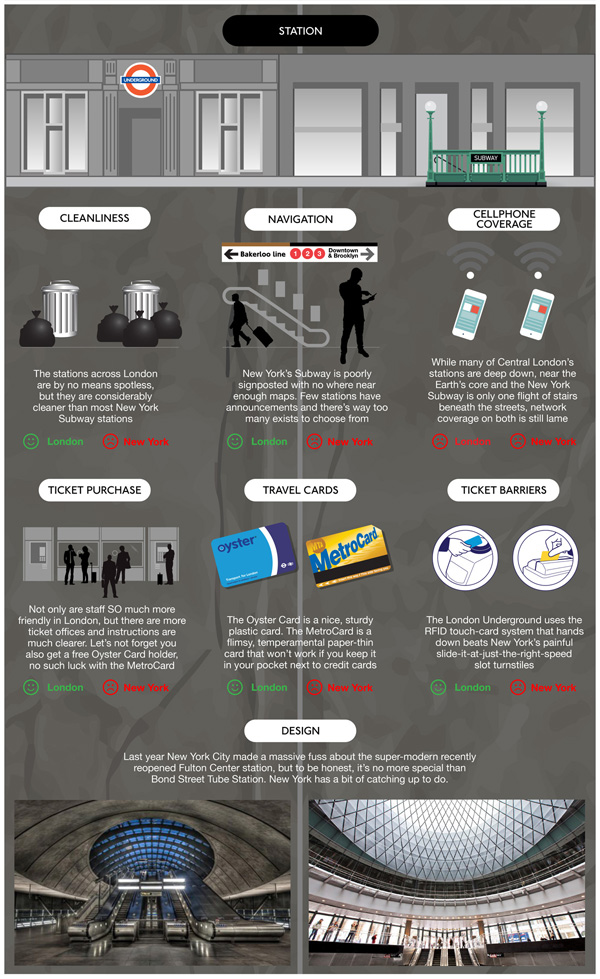London Underground vs New York Subway
27/08/2015
A few years ago, a writer for The Guardian by the name of Bim Adewunmi was utterly ripped to shreds on the internet after she called the New York subway system “patently ridiculous” and “the work of a sadist, cooked up in a fever dream and delivered with a flourish and an unhinged grin”.
She took issue with the subway maps, which she called “a mess of fonts and colours” and with the whole idea of making multiple lines the same colour:
“The city’s subway map is dense and needlessly complex,” she said. “Where in London the Central line (red) is distinct from the Piccadilly (dark blue), which is markedly different from the Hammersmith and City line (pink), New York’s map has designated the same forest green to the 4, the 5 and the 6 lines. The B, D, F and M all rejoice in exactly the same shade of violent orange. And I’m almost entirely certain that the blue of the A, C, and E lines is the last thing you see before death’s sweet embrace. Why would you do this? The whole thing resembles a child’s approximation of a city transit system: it makes no sense.”
The response to this on Twitter was intelligent and well thought through, naturally, with comments including “NYC is not for simpletons with the brain of a cane toad and beauty of a Blobfish” and “the subway is fairly simple actually, just stop being dumb”.
The thing is…to a large extent, she’s right and I can fully understand where she’s coming from. To any visitor, the New York Subway system is a challenge. I have friends who think the Paris Metro system is easier to understand and they don’t speak a single word of French. I don’t know if I’d go as far as to call it the work of a fevered sadist, but it is not as clearly laid out as it could be, especially at stations. Sure, if you’ve lived in New York for years, you’ve worked it out, but compared to the London Underground, navigation can be tricky. And that’s something many New Yorkers freely admit.
Home for me is East London and has been for 15 years, but I moved to Manhattan about three years ago and like everything associated with that kind of transition, anything new takes a while to get used to. However, there is one universal truth I’ve discovered that certainly applies to this particular comparison; if you took the best elements of the London Underground and put them together with the best elements of the New York Subway, you’d probably have one of the best subterranean mass transit systems in the world.
The first big difference is how the journey is undertaken. In London, you pay for the distance travelled between touching in and touching out, generally measured in zones. In New York, it’s a flat fare regardless of where you’re going. However, one trip equals one fare. You can change lines, but should you need to suddenly turn around for any reason, you’d have to wait until you got to a bigger station with a centralized area, like Penn Street, Fulton Street, Grand Central and so on, where you can change platform without having to exit, but there aren’t many like this. This becomes particularly relevant when you’ve got on the wrong train by accident and need to reverse direction. Try explaining that to the unhelpful employee behind what appears to be 10-inches of reinforced nuclear missile-proof glass. More than likely she’ll tell you that you either have to keep going until you get to a station where you can change platform, or bite the bullet, exit, re-enter on the other side and pay the extra fare.
It also means that the equivalent trip from say, Holloway Road to Heathrow costs the same as Holborn to Holland Park. Naturally, there are pros and cons on both sides of these different approaches to the same problem, depending on your daily commute.

Sadly, this simple and helpful idea has yet to adopted by the New York subway
Probably the biggest problem with the New York Subway is trying to comprehend the mess of different trains that all run on the same coloured lines. It is very easy to accidentally get onto an express train and fly 15 stops past where you needed to get off. However, once you have mastered it, and you do need to miss out a whole bunch of stations in-between your start and stop point, this can prove quite useful.
The stations themselves can be as confusing as the train network. There are multiple entrances and exists, rather than just a big one and each specific entrance/exit relates to whether the platform that it leads to is going uptown (north) or downtown (south). So, you’ll probably have to cross the road a few times to get the right one. One design student experimented with the mind-boggingly useful idea of putting signs at eye-level on the stairs (picture above), but this has yet to be adopted by the MTA.
The stations in New York aren’t as bright or as clean as their UK equivalents, instead looking much more gothic, gritty and possibly even gloomy, but that’s a matter of personal taste. (I’ve always thought the platform at Mile End looks just like a typical New York Subway station.) There isn’t much in the way of maps on the walls and the actual station name is often on a sign on the side of the cast iron pillars making quite hard to spot from sitting inside the train carriage. And if you’re seating with your back to the platform you can forget any chance of being able to see the name of the station – they haven’t got any signs on the far wall like London. The platforms and stations themselves aren’t air-conditioned; instead they have many vents since the street is sometimes only 10 metres above you. This means they can get very hot during the summer and pretty cold during the winter.
However, the carriages are air-conditioned and it’s very effective. In London you’d never find yourself wishing a train would come along for the added reason that you can cool off inside rather than waiting in the heat on the platform. They are also so much bigger, which means tall people don’t have to hunch, ever. In fact, generally speaking, the carriages are much better than those in London. No, they’re not as modern, but the plastic seats don’t feel disgusting to sit on like London’s festering, germ-magnet material seats and could even be quickly wiped with a Wet One should you feel so inclined. There’s also room under the seats to slide suitcases and bags, which is very useful.
Personally, I also prefer the almost art-deco aluminum design of New York’s trains. Both London and New York boast Wi-Fi on their underground networks, but in reality, both are still a little patchy. You can get connections at the stations, but in-between it’s non-existent. As for passenger weirdness, well, you get it in both cities – you can watch a lady chopping onions on the Subway, or watch a suit sniff a line of Charlie on the Tube.
Actually getting your MetroCard to open the barrier is a whole new nightmare. At some point, I’d like to get a radar gun and determine exactly what speed it is that the cards have to be slide through, but I already know that a variation, faster or slower, of just an infinitesimal amount will result in requiring another attempt and a chorus of “tuts” from the New Yorkers behind you. That said, how many times have you been at full momentum at Bank when someone in front of you hasn’t kept their Oyster Card topped up? But, the fact remains that the contactless smartcard technology of the durable plastic Oyster is so, so much better than the ridiculous flimsy, thin MTA card of the Subway. It’s worth remembering though, because it’s structured on a flat fare system, you don’t have to tap out in New York. If you could somehow combine the two systems, you’d have a winner.
For a tourist, the New York Subway can be a nightmare, but that itself is very a New York state of mind and they’re proud of it. Not that long ago a street vendor near the World Trade Center was busted for charging tourists $30 for a hot dog. The reaction of many New Yorkers in the comments section was that it’s your own damn fault if you get ripped off; get wise or get out.
New Yorkers are not malicious or vindictive, they just don’t give a shit about you. No one here will hold open a heavy shop door for you, ever. It’s not that they’re deliberately rude, they just have absolutely no concept of anyone else. No one in New York will stand up and offer an elderly or pregnant person their seat. I’ve done it, but then I’m British and all that happened was the elderly person looked at me quizzically and said she was fine standing.
In New York City, you can get killed from falling building materials, hit with exploding man hole covers or pushed in front of a train. It’s a zoo, it’s a jungle out there and New Yorkers wouldn’t have it any other way.
The London Underground is easier to navigate, the New York Subway has bigger, actual air-conditioned cars, the stations are cleaner in London, New York is cheaper. The staff are so much nicer in London, you don’t have to travel to the centre of the Earth to get to a train in New York. And on it goes. The space issue counts for a lot, it’s not just one tick in a box for New York. Yes, London has an older network, it covers a bigger area, but New York has more stations, more lines (technically speaking) and carries more people each year.
It’s a close call. However, New York’s antiquated ticket system really lets the side down. Not only is the specific-speed-slide-thing an absolute nightmare, but quite some smaller stations have no ticket machines and often you’ll never find actual human beings in the ticket booths of larger stations. During the winter, New York’s stations are as cold as the streets above, but during the very humid Autumn, particularly in August, you’ll stand on the platform and sweat pints. Add to that the shocking number of times people seem to fall on the tracks – it’s almost weekly – and the equally shocking number of people who openly bang one out while on the train, it can easily fill you with a sense of trepidation when travelling on the New York subway, especially late at night, or early in the morning.
New York City’s public transport infrastructure is spectacularly out of date. It’s almost quaint to see the carriages rattle into the station and there’s definitely a certain charm if you’re just visiting New York. But if you live here…and you’ve at least spent time in other cities, particularly in Europe or Japan, then the novelty eventually wears off and you’ll see how the rest of the world is developing and the US has been standing still for decades.
It’s a close call, but, London wins.


